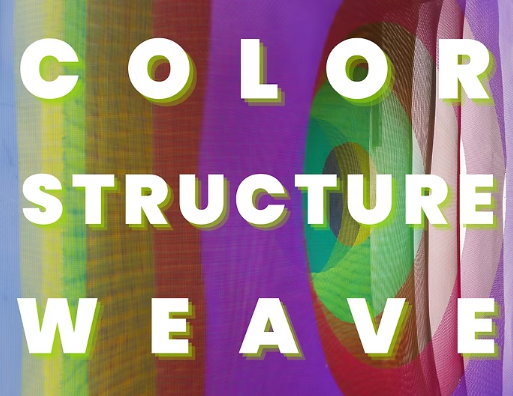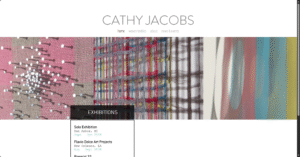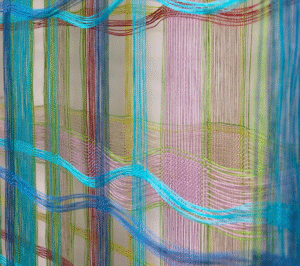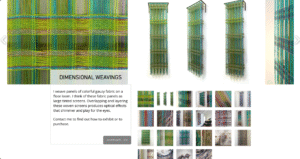Weave your artistic creation

Summary
The core focus of this Open Toolkit is to enable you to complete a small weaving art installation in the style of Cathy Jacobs within 20 minutes. You can create a mini work of 10 to 15cm that can be directly used as a desktop decoration. The content will be revolve around the construction of simple weaving frames, teaching of basic weaving techniques, and color matching, which simplify processes to enable the younger generation to come into contact with and fall in love with traditional skills. The entire learning process does not pursue complex skills, but rather focuses on allowing learners to experience the fun and openness of weaving art. Thus, please feel free and creative to join this course!

Have you ever tried weaving items?
Introduction
Weaving
The history of weaving technology is very long. This technique mainly uses crochet as the tool and adjusts the density and texture of the fabric through a combination of stitches As for weaving art, which is a kind of art with thread as the core material. The creator uses techniques such as winding, interweaving, knotting and shuttling to construct linear materials into flat or stereo forms. This course breaks down traditional weaving techniques into short, fragmented open knowledge. You can create artworks with your own personal characteristics by drawing on Cathy Jacobs’ creative style. Weaving skills can be transformed into open knowledge that can be mastered in a short time, helping you relax and relieve stress through handicraft creation in a fast-paced life. At the same time, you can experience the beauty of the integration of traditional craftsmanship and modern art.
Cathy Jacobs
Cathy Jacobs is a textile artist based in Michigan. She positions herself as a painter of weaving. In terms of creation, she focuses on creating a dynamic color field through the interweaving of multiple layers of linen panels. Reflect the inner world in an abstract form. The core is filled with the pursuit of control and freedom, casualness and precision, structure and irregularity. Layering is her consistent creative concept. She compares layers of fabric to barriers that carry past memories and experiences.

https://www.cathyjacobs.com/
How to make it?

Step 1
Preparation(2 minutes)
Materials: 3-4 different colors and materials of yarn, scissors, clips, glue, tape measure, woven frame (finished product or homemade from cardboard), and optional decorative materials (such as small beads).
Tool inspection: Confirm that all materials are complete. If you need to make your own frame, prepare the cutting tools in advance to assist in the processing of the cardboard.
Step 2
Mini woven frame setup (2 minutes)
If you have ready-made frames, this step can be omitted. You can take a piece of cardboard, draw a rectangular border of about 10cm×15cm with a ruler, and then cut it out with scissors. Then fix the four corners of the cardboard with clips or glue to prevent it from sliding. If the edges of the border are not neat, you can quickly trim them flat with scissors to complete the frame construction.
Step 3
Wool thread fixation (2 minutes)
Please select a basic color of wool as the warp thread and fix one end of it to one side of the upper edge of the frame with a clip. You can pull the yarn along the longitudinal direction of the frame to the corresponding position at the lower edge and fix it with clips or glue to ensure that the yarn is flat and taut.
Step 4
Straight line Interweaving practice (3 minutes)
Choose a yarn with a different color from the base color.
Fix one end of the color-matched wool to the left edge of the frame.
Use both hands to cooperate and pass the color-matched wool horizontally through the warp from the top to the bottom of the frame.
Follow the interweaving rule of one top and one bottom.
During the process, the tightness of the wire should be kept consistent.
Step 5
Curve Winding Learning (5 minutes)
Change to another color of wool.
Fix one end of this kind of yarn at the middle position on the left side of the frame.
Refer to the short video operation with a close-up of the hand.
Wrap the wool around the warp in a simple curve.
Deliberately avoid regular shapes and present natural irregular curves.
If the wire deviates during the winding process, its position should be adjusted in time to ensure a smooth curve.
Step 6
Final Fixation and Work Optimization (2 minutes)
Fix the ends of all the wool to the back of the frame with clips or by tying knots.
Then use scissors to trim the excess wire at the edge of the frame.
View the reference image of the work.
Try adding small beads or trying to change the material of some of the wires
To optimize the visual effect of the work.
(https://www.cathyjacobs.com/news-and-events)



